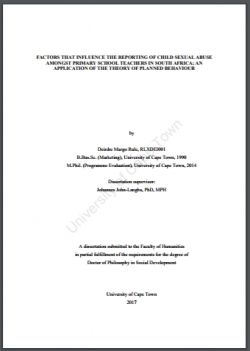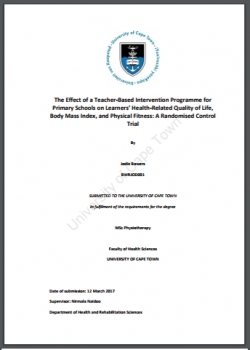Health-related physical fitness and risk factors associated with obesity among primary school children in the Limpopo and Mpumalanga provinces of South Africa

Type
Thesis
Authors
Category
ECCE, Foundation, Intermediate
[ Browse Items ]
Publication Year
2014
Publisher
North West University, Potchefstroom, South Africa
URL
[ private ]
Pages
173 p.
Subject
Early childhood development, Early childhood education, Foundation Phase, Intermediate Phase, Primary education, Children, Childhood obesity, Anthropometry, Body composition, Health-related fitness, Risk factors, Physical activity, South Africa
Tags
Abstract
It is well documented that behavioural and biological risk factors for Chronic Diseases of Lifestyle (CDL) such as overweight and high blood pressure persist from childhood into adulthood. CDL is considered to be a group of diseases that shares similar risk factors as a result of exposure over many decades to physical inactivity, unhealthy diets, smoking, lack of regular exercise, and possibly stress. This study assessed health-related physical fitness and risk factors associated with obesity among 1361 (boys: n=678; girls: n=683) primary school children aged 9-12 years in the Limpopo (LP) and Mpumalanga (MP) Provinces, South Africa. Anthropometric and physical fitness measurements were taken using the protocol of the International Society for the Advancement of Kinanthropometry (ISAK) (Marfell-Jones, et al., 2006) and EUROFIT (1988) test batteries. Body composition measures included body mass index (BMI) (weight/height2), percentage body fat (%BF) and waist-to-hip ratio, respectively. BMI for age and gender was used to classify the children as underweight, overweight or obese (Cole et al., 2007), whilst %BF calculated from the sum of two skinfolds (triceps and subscapular) using the equation of Slaughter et al. (1988) indicated adiposity. The International Physical Activity Questionnaire (IPAQ) was used to categorise the children’s physical activity (PA) level as follows: Low (METs scores of less than 500); Moderate (METs scores from 500 to 1499) or High (METs >1500). In general, 75% of the children were underweight/stunted and 1.6% overweight. Frequencies of underweight, normal weight and overweight were 77%, 22.4% and 0.2% in MP and 72%, 24% and 3% in LP province. Boys were generally taller and heavier than girls. At age 10 the MP boys performed significantly (p=0.05) better in sit-ups (SUP: 20.5 ±5.4) than the LP boys (18.6±6.56). However, the LP boys performed significantly better than the MP boys in sit-and-reach (SAR) at ages 10 and 11. The MP boys performed significantly (p=0.00) better in SBJ (121.6±9.1cm) compared to the Limpopo (118.4±11.00cm) boys at age 9. Generally, LP boys were significantly (p=0.00) better than the MP boys across all ages. The PA results showed that 27.7% (377), 58.5% (796) and 13.8% (188) of the children participate in low, moderate and high PA, respectively. Children in the MP province had higher PA (28.6%) in comparison to the low PA participation in LP children (26.7%). Furthermore, 59.7% of MP children compared to the LP children (57.3%) participate in moderate PA. A higher PA participation rate (15.8%) was found among the LP than MP children (11.6%). The girls had non-significantly higher BP values (systolic: 112.94±11.28mmHg; diastolic: (79.40±12.80mmHg) than boys (systolic: 110.71±14.95mmHg; diastolic: (75.53±12.53mmHg) who had higher PA levels (METs =1286.72±317.47) than girls (METs =397.28±30.14) (p<0.01). A total of 81% (n=1089) and 19% (n=253) of the combined samples had normal BP and prehypertension, respectively. When controlled for provinces, gender and age, results indicated that BMI was negatively associated with systolic BP (SBP) (-0.54) (p<0.01), but positively correlated with %BF (0.133) (p<0.01), whilst SBP related positively with %BF (0.125) (p<0.01). The children’s PA level correlated positively with BMI (0.86) (p<0.01) but negatively with %BF (-0.67); weight circumference (WC) (-0.41); SUP (sit-up) (-0.22); and predicted 2max • VO (-0.17) (p<0.05). The high percentage of underweight and pre-hypertensive children in the study warrants an urgent need to periodically evaluate PA levels among South African children and design appropriate intervention programmes to alleviate concerns over body weight disorders and low PA levels in children, thus optimising health outcomes.
Number of Copies
1
| Library | Accession No | Call No | Copy No | Edition | Location | Availability |
|---|---|---|---|---|---|---|
| 1 | Potchefstroom, North West Province, South Africa | Yes |


